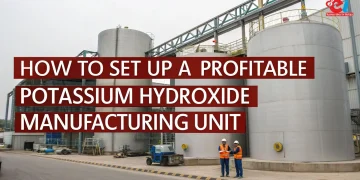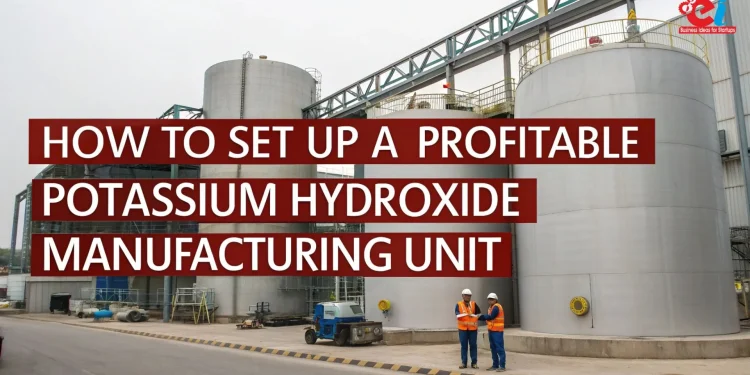Potassium Hydroxide or KOH is commonly referred to as caustic potash and is a major alkaline industrial chemical. Its high water solubility, basic nature, and multifunctional capabilities make it critical for a variety of industrial processes and formulations. This chemical is used in agriculture, pharmaceuticals, food processing, battery manufacturing, soap manufacturing, and many more, making its market value soar globally. Domestically, the continuous increase in industrialization, fertilizer production, and exports of specialty chemicals is aiding the growing demand for Potassium Hydroxide.
KOH Entrepreneurs wishing to set up a Potassium Hydroxide Manufacturing need to have a proper understanding of the chemical process involved along with the necessary infrastructure, financing, regulations, and scope for export and domestic sales. To help bring the ideas to execution, NPCS provides a reliable partner with industrial consulting services through detailed techno-economic feasibility reports that guide such projects right from inception to execution.
Current Trends in the Market and Consumption of Potassium Hydroxide
The demand for Potash Hydroxide is rising globally due to the expansion of the downstream value chain like alkaline batteries, potassium fertilizers, cleansing liquid soaps, and even specialty food items. Its role as a catalyst in biodiesel production and as a major constituent in pharmaceutical preparations further underlines its industrial significance. The potassium-rich KOH formulations used in organic farming are becoming popular due to sustainability focus.
The dependence on import of potassium chemicals positions India favorably for domestic production. The Production-Linked Incentive (PLI) scheme and the self-reliant ‘Atmanirbhar Bharat’ policy are enhancing the Chemical Industry investment prospects. Soon Indian entrepreneurs will be able to meet the domestic demand and subsequently shift focus to the export opportunities in the Middle East, Africa, and even Southeast Asia.
Technology Flow and Potassium Hydroxide Manufacturing Process
The potassium hydroxide production method that is most popular among industries is the electrolysis of potassium chloride (KCl) brine. This is known to be one of the most effective techniques for its productivity, level of purity, and ease of scaling. Every production process begins with the making of a potassium chloride solution in water and its subsequent purification step where calcium, magnesium, and other metallic impurities that interfere with the electrochemical reaction are removed.
The brine undergoes membrane electrolysis in specially designed cells for potassium hydroxide production. The separation of potassium ions from chloride ions is possible within the membrane cell. In the cathode compartment, water reduction occurs and hydrogen gas and hydroxide ions are formed. Hydroxide that is produced reacts with potassium ions that are migrating through the membrane to yield Potassium Hydroxide in solution form. At the anode, chloride ions get oxidized at and chlorine gas is released. Optimum yield and safety require specific voltages, temperatures, and current densities to be controlled for the complete process.
After KOH is produced through electrolysis, its KOH solution must undergo multi-effect evaporators to concentrate to about 46% – 50%. If the desired end product is solid “dry” flakes, then the solution must be fed into a flaker system which cools the chemical into white crystalline flakes. During the entire process of electrolysis, chlorine and hydrogen gas are produced as by-products. These by-products are collected and stored in a safe manner where they can autonomously be sold, or used in other internal processes, or allied chemical processes hydroponically deemed.
Related: Start Potassium Hydroxide Business With low Investment
Machinery and Equipment Required
Potassium Hydroxide production facilities require potassium electrolytic units that deal with the integration of multiple dielectric fluid systems set for a hydraulic infrastructure, pumping, chemical process unit flunctions set for Fluid Transport, electric chemical reactions, work up cascading processing, spray drying, and automatic kitting or packaging of the product. These components make up the parts list for a Aims potentiometric unit.
The system for controlling the voltage without external regulation selects the pole for voltage control, which stimulates the reactors for combustion of the raw materials. The first stage of the fabrication system where brine solution forms involves the electrolytic cells where enormous amounts of potassium chloride are stored. Hall and copper cells are the most common types of electrolytic cells. Scale forming ions are stripped from the brine and the brine pumped into filter with magnesium stranding the strainer. The filter becomes the lacrimator containing magnesium.
The heart of the plant are the electrolysis cells. The electrolysis cells are, or in “‘crowned’” membrane cells, where modern diaphragm cell technology use surfaces made of titanium. These electrodes gently alter the current that toward stationary pieces of ceramized mycelium of titanium and steel as a basis reinforced with nickel.” and elongate the lifetime.
Gas-liquid separators follow after the electrolysis units. Here, the chlorine and hydrogen gases are extracted and stored in gas holders or cylinders. From here, the KOH solution flows into evaporators – typically triple-effect or forced circulation types – where, under reduced pressure and controlled heating, water is removed. The concentrated solution can be kept as a liquid or sent to a stainless steel drum flaker where the liquid turns to flakes as it cools.
Automated bagging machines, control panels, brine circulation pumps and safety scrubbers are part of the additional equipment. Control and monitoring can be done in real time with a Distributed Control System (DCS) or SCADA unit, which is commonly used throughout the entire plant.
Infrastructure and Utility Requirements
The scale of operations and degree of automation primarily dictate the plant’s infrastructural needs. A land area of about 1.5-2 acres is needed for the storage and processing of raw materials, in order to produce 10 tons of Potassium Hydroxide a day. This also includes the utilities block, QC labs, administrative offices and effluent treatment plant.
Power is one of the many inputs needed, especially for electrolysis, which is power intense. Depending on the capacity, power requirements can range between 1.5 to 2 megawatts. It is advisable for entrepreneurs to either get power from dedicated industrial feeders or to invest in captive generation options. Water usage is considerable for brine preparation, cooling, and cleaning, is typically in the region of 25000-50000 liters per day. Water must be treated to DM (demineralized) quality for the best efficiency in electrolysis.
The treatment of effluents is one of the most important aspects of the infrastructure. Special effluent treatment systems are needed for brine regeneration, spent liquor handling, and chlorine residue bearing waste treatment. Air scrubbers, chlorine neutralization chambers, and gas detectors are mandatory secondary measures due to the aggression of some by-products.
Related: Potassium Permanganate Business: Profitable Opportunities Await
Adherence to Government Policies on Safety and Environmental Protection
The construction of a chemical manufacturing unit requires compliance to environmental, industrial, and safety policies and regulations. The State Pollution Control Board has prerequisites for environmental clearances which include emissions, effluent discharge, and solid waste management permits. A plant needs to obtain a Consent To Establish (CTE) and a Consent To Operate (CTO).
There may be a need for permits from the Petroleum and Explosives Safety Organization (PESO) due to the presence of chlorine and hydrogen. Also, selling Potassium Hydroxide to the food or pharmaceutical industries might necessitate BIS certification. Other legally required obligations include regular independent assessments, compliance with the Factories Act, worker health and safety policies, and other internal policies.
Strategic Positioning, Exportable Products and Services
Export possibilities on Potassium Hydroxide are exploitative due to growing trade relations and Free Trade Agreements (FTA) India has with the Middle East, Southeast Asia, and parts of Africa. KOH is specifically purchased in bulk by countries that lack the ability to produce chemicals for fertilizers, agro-processing, and industrial cleaning agents.
A KOH exporting manufacturing vertical needs to be REACH compliant and likewise, have the capability to offer food-grade or pharma-grade purity if directed towards niche markets in need. Indian manufacturers can emerge as a dependable global source if they have the necessary ISO certifications along with Quality Control QC traceability and a well developed logistics network.
NIIR Project Consultancy Services Help
NIIR Project Consultancy Services NPCS offer Potassium Hydroxide KOH projects ready to devise business strategies and provide a detailed step-by-step implementation plan to interested entrepreneurs. NPCS project reports are backed by the latest market data, scientific manufacturing processes and financial viability assessments.
In our documentation titled ‘Manufacture of Caustic Potash Flakes from KCl’, we provide complete instructions including but not limited to raw material specifications, process flow diagrams, supplier lists, site evaluation, profitability evaluation, and compliance audit checklist. NPCS has the best data for new investors and seasoned professionals in the chemical industry, no matter the position you hold.
Conclusion
Potassium Hydroxide Hydroxide is not only an industrial chemical; it is an important industrial raw material for various processes in many modern manufacturing chains. There is a growing demand which UK and KOH market can cater to by substituting imports as well as having favorable industrial policies, therefore establishing KOH production plants in India is very beneficial.
Business visions can be transformed into sustainable success stories if accompanying modern electrolysis technology and this chemical initiative are teamed up with compliant safety policies and strong partners like NIIR Project Consultancy Services.
Contact us today and we will guide you on setting up a Potassium Hydroxide production unit. Rest assured that at NIIR, we will accompany you through every step of your journey.


























